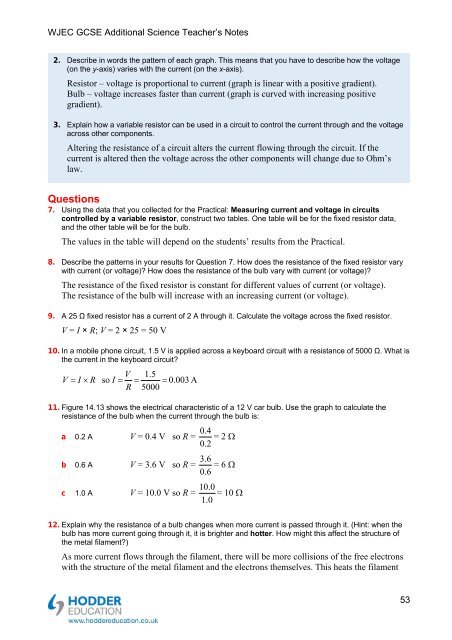Teacher's notes and answers to questions in the book - Hodder Plus ...
Teacher's notes and answers to questions in the book - Hodder Plus ...
Teacher's notes and answers to questions in the book - Hodder Plus ...
You also want an ePaper? Increase the reach of your titles
YUMPU automatically turns print PDFs into web optimized ePapers that Google loves.
WJEC GCSE Additional Science Teacher’s Notes<br />
2. Describe <strong>in</strong> words <strong>the</strong> pattern of each graph. This means that you have <strong>to</strong> describe how <strong>the</strong> voltage<br />
(on <strong>the</strong> y-axis) varies with <strong>the</strong> current (on <strong>the</strong> x-axis).<br />
Resis<strong>to</strong>r – voltage is proportional <strong>to</strong> current (graph is l<strong>in</strong>ear with a positive gradient).<br />
Bulb – voltage <strong>in</strong>creases faster than current (graph is curved with <strong>in</strong>creas<strong>in</strong>g positive<br />
gradient).<br />
3. Expla<strong>in</strong> how a variable resis<strong>to</strong>r can be used <strong>in</strong> a circuit <strong>to</strong> control <strong>the</strong> current through <strong>and</strong> <strong>the</strong> voltage<br />
across o<strong>the</strong>r components.<br />
Alter<strong>in</strong>g <strong>the</strong> resistance of a circuit alters <strong>the</strong> current flow<strong>in</strong>g through <strong>the</strong> circuit. If <strong>the</strong><br />
current is altered <strong>the</strong>n <strong>the</strong> voltage across <strong>the</strong> o<strong>the</strong>r components will change due <strong>to</strong> Ohm’s<br />
law.<br />
Questions<br />
7. Us<strong>in</strong>g <strong>the</strong> data that you collected for <strong>the</strong> Practical: Measur<strong>in</strong>g current <strong>and</strong> voltage <strong>in</strong> circuits<br />
controlled by a variable resis<strong>to</strong>r, construct two tables. One table will be for <strong>the</strong> fixed resis<strong>to</strong>r data,<br />
<strong>and</strong> <strong>the</strong> o<strong>the</strong>r table will be for <strong>the</strong> bulb.<br />
The values <strong>in</strong> <strong>the</strong> table will depend on <strong>the</strong> students’ results from <strong>the</strong> Practical.<br />
8. Describe <strong>the</strong> patterns <strong>in</strong> your results for Question 7. How does <strong>the</strong> resistance of <strong>the</strong> fixed resis<strong>to</strong>r vary<br />
with current (or voltage) How does <strong>the</strong> resistance of <strong>the</strong> bulb vary with current (or voltage)<br />
The resistance of <strong>the</strong> fixed resis<strong>to</strong>r is constant for different values of current (or voltage).<br />
The resistance of <strong>the</strong> bulb will <strong>in</strong>crease with an <strong>in</strong>creas<strong>in</strong>g current (or voltage).<br />
9. A 25 Ω fixed resis<strong>to</strong>r has a current of 2 A through it. Calculate <strong>the</strong> voltage across <strong>the</strong> fixed resis<strong>to</strong>r.<br />
V = I × R; V = 2 × 25 = 50 V<br />
10. In a mobile phone circuit, 1.5 V is applied across a keyboard circuit with a resistance of 5000 Ω. What is<br />
<strong>the</strong> current <strong>in</strong> <strong>the</strong> keyboard circuit<br />
V<br />
I R<br />
V<br />
so I <br />
R<br />
1.5<br />
5000<br />
0.003 A<br />
11. Figure 14.13 shows <strong>the</strong> electrical characteristic of a 12 V car bulb. Use <strong>the</strong> graph <strong>to</strong> calculate <strong>the</strong><br />
resistance of <strong>the</strong> bulb when <strong>the</strong> current through <strong>the</strong> bulb is:<br />
a 0.2 A V = 0.4 V so R =<br />
b 0.6 A V = 3.6 V so R =<br />
c 1.0 A V = 10.0 V so R =<br />
0.4<br />
= 2 <br />
0.2<br />
3.6<br />
= 6 <br />
0.6<br />
10 .0 = 10 <br />
1.0<br />
12. Expla<strong>in</strong> why <strong>the</strong> resistance of a bulb changes when more current is passed through it. (H<strong>in</strong>t: when <strong>the</strong><br />
bulb has more current go<strong>in</strong>g through it, it is brighter <strong>and</strong> hotter. How might this affect <strong>the</strong> structure of<br />
<strong>the</strong> metal filament)<br />
As more current flows through <strong>the</strong> filament, <strong>the</strong>re will be more collisions of <strong>the</strong> free electrons<br />
with <strong>the</strong> structure of <strong>the</strong> metal filament <strong>and</strong> <strong>the</strong> electrons <strong>the</strong>mselves. This heats <strong>the</strong> filament<br />
53

















